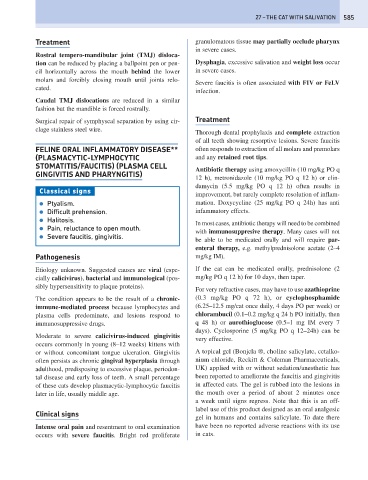Page 593 - Problem-Based Feline Medicine
P. 593
27 – THE CAT WITH SALIVATION 585
Treatment granulomatous tissue may partially occlude pharynx
in severe cases.
Rostral tempero-mandibular joint (TMJ) disloca-
tion can be reduced by placing a ballpoint pen or pen- Dysphagia, excessive salivation and weight loss occur
cil horizontally across the mouth behind the lower in severe cases.
molars and forcibly closing mouth until joints relo-
Severe faucitis is often associated with FIV or FeLV
cated.
infection.
Caudal TMJ dislocations are reduced in a similar
fashion but the mandible is forced rostrally.
Surgical repair of symphyseal separation by using cir- Treatment
clage stainless steel wire.
Thorough dental prophylaxis and complete extraction
of all teeth showing resorptive lesions. Severe faucitis
FELINE ORAL INFLAMMATORY DISEASE** often responds to extraction of all molars and premolars
(PLASMACYTIC-LYMPHOCYTIC and any retained root tips.
STOMATITIS/FAUCITIS) (PLASMA CELL Antibiotic therapy using amoxycillin (10 mg/kg PO q
GINGIVITIS AND PHARYNGITIS)
12 h), metronidazole (10 mg/kg PO q 12 h) or clin-
damycin (5.5 mg/kg PO q 12 h) often results in
Classical signs
improvement, but rarely complete resolution of inflam-
● Ptyalism. mation. Doxycycline (25 mg/kg PO q 24h) has anti
● Difficult prehension. infammatory effects.
● Halitosis.
In most cases, antibiotic therapy will need to be combined
● Pain, reluctance to open mouth.
with immunosuppresive therapy. Many cases will not
● Severe faucitis, gingivitis.
be able to be medicated orally and will require par-
enteral therapy, e.g. methylprednisolone acetate (2–4
Pathogenesis mg/kg IM).
Etiology unknown. Suggested causes are viral (espe- If the cat can be medicated orally, prednisolone (2
cially calicivirus), bacterial and immunological (pos- mg/kg PO q 12 h) for 10 days, then taper.
sibly hypersensitivity to plaque proteins).
For very refractive cases, may have to use azathioprine
The condition appears to be the result of a chronic- (0.3 mg/kg PO q 72 h), or cyclophosphamide
immune-mediated process because lymphocytes and (6.25–12.5 mg/cat once daily, 4 days PO per week) or
plasma cells predominate, and lesions respond to chlorambucil (0.1–0.2 mg/kg q 24 h PO initially, then
immunosuppressive drugs. q 48 h) or aurothioglucose (0.5–1 mg IM every 7
days). Cyclosporine (5 mg/kg PO q 12–24h) can be
Moderate to severe calicivirus-induced gingivitis
very effective.
occurs commonly in young (8–12 weeks) kittens with
or without concomitant tongue ulceration. Gingivitis A topical gel (Bonjela ®, choline salicylate, cetalko-
often persists as chronic gingival hyperplasia through nium chloride, Reckitt & Coleman Pharmaceuticals,
adulthood, predisposing to excessive plaque, periodon- UK) applied with or without sedation/anesthetic has
tal disease and early loss of teeth. A small percentage been reported to ameliorate the faucitis and gingivitis
of these cats develop plasmacytic-lymphocytic faucitis in affected cats. The gel is rubbed into the lesions in
later in life, usually middle age. the mouth over a period of about 2 minutes once
a week until signs regress. Note that this is an off-
label use of this product designed as an oral analgesic
Clinical signs
gel in humans and contains salicylate. To date there
Intense oral pain and resentment to oral examination have been no reported adverse reactions with its use
occurs with severe faucitis. Bright red proliferate in cats.

